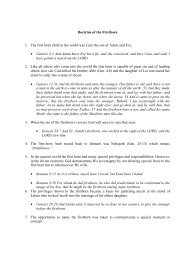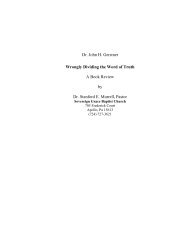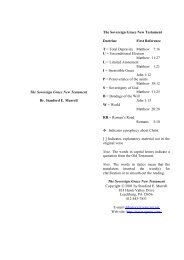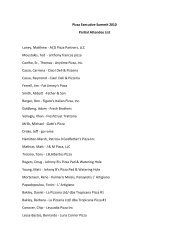Create successful ePaper yourself
Turn your PDF publications into a flip-book with our unique Google optimized e-Paper software.
13 Thy plants are an orchard <strong>of</strong> pomegranates, with pleasant fruits; camphire,<br />
with spikenard,<br />
14 Spikenard and saffron; calamus and cinnamon, with all trees <strong>of</strong> frankincense;<br />
myrrh and aloes, with all the chief spices:<br />
4:14 plants. The purpose <strong>of</strong> a garden is not only to look lovely but to produce. The purpose <strong>of</strong> the<br />
church is not just to appear lovely but to produce spiritual fruit for the Lord. Philippians 1:9 And<br />
this I pray, that your love may abound yet more and more in knowledge and in all judgment; 10<br />
That ye may approve things that are excellent; that ye may be sincere and without <strong>of</strong>fence till the<br />
day <strong>of</strong> Christ; 11 Being filled with the fruits <strong>of</strong> righteousness, which are by Jesus Christ, unto the<br />
glory and praise <strong>of</strong> God.<br />
4:14 spikenard refers to a rose red fragrant ointment made from the dried roots <strong>of</strong> a plant growing<br />
in the mountains <strong>of</strong> northern India.<br />
4:14 saffron, a sweet smelling plant with purplish flowers and orange stigmas. The plant was<br />
used for a dye, seasoning, and medicine.<br />
4:14 calamus (cal'-a-mus), refers to a sweet fragrant reed plant. It was one <strong>of</strong> the substances<br />
Moses used to make the oil used for anointing (Ex. 30:23). The plant was used for medicinal<br />
purposes <strong>of</strong> gastric complaints.<br />
4:14 cinnamon. The cinnamon tree was not found in Palestine during biblical days. The sweet<br />
smelling bark was highly prized as it was brought from China to Judea by the Phoenicians and<br />
the Arabs in caravans traveling through Persia.<br />
4:14 frankincense refers to a fragrant bitter tasting gum resin that was extracted from various<br />
varieties <strong>of</strong> the balsam tree in east Africa and in south Arabia.<br />
4:14 myrrh refers to an aromatic resin that was highly valued. The resin sap has a clear, oily<br />
consistency and is white or yellowish in color.<br />
4:14 aloes refers to a plant which produced oil which provided valued perfume.<br />
4:14 spice may refer to the mastic tree which is an evergreen. This small deciduous shrub has<br />
composite leafs which consists <strong>of</strong> eight smaller leaves. These contain fragrant volatile oils which<br />
are emitted when the leaves are crushed. The trunk and thicker branches contain resin, which is<br />
released when the bark is cut. It is a pale color, or sometimes greenish, and has a pleasant odor<br />
and taste. Oil is pressed from the small, round brownish-black root which was used for cooking<br />
and in loaves. The resin and oil <strong>of</strong> the mastic tree was used for embalming.<br />
15 A fountain <strong>of</strong> gardens, a well <strong>of</strong> living waters, and streams from Lebanon.<br />
47











